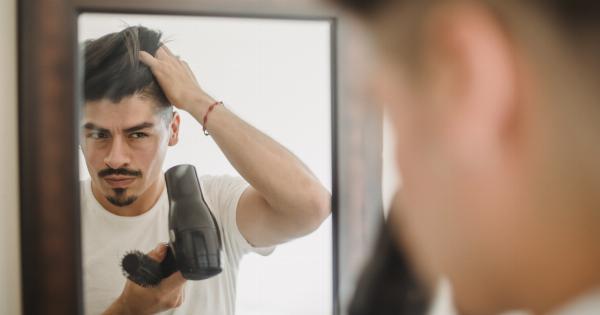Alopecia, also known as hair loss, is a common condition that affects millions of people worldwide. It can occur in different forms and have various underlying causes.
In this article, we will explore the different types of alopecia, their symptoms, causes, and possible treatments.
1. Androgenetic Alopecia
Androgenetic alopecia, also known as male or female pattern baldness, is the most common form of hair loss. It is characterized by a gradual thinning of hair on the scalp, typically starting at the hairline or crown.
The primary cause of androgenetic alopecia is believed to be genetic factors and hormonal changes.
In men, the hormone dihydrotestosterone (DHT) plays a crucial role in hair loss, while in women, hormonal imbalances like polycystic ovary syndrome (PCOS) can contribute to this condition.
2. Alopecia Areata
Alopecia areata is an autoimmune disorder in which the immune system mistakenly attacks the hair follicles, resulting in smooth, round patches of hair loss on the scalp or other parts of the body.
It can occur at any age and may lead to complete baldness in severe cases.
The exact cause of alopecia areata is still unknown, but it is believed to be a combination of genetic and environmental factors. Stress, certain medications, and viral infections may also trigger or exacerbate this condition.
3. Telogen Effluvium
Telogen effluvium is a temporary form of hair loss that occurs when a large number of hair follicles enter the resting (telogen) phase simultaneously.
This often happens due to physical or emotional stress, hormonal changes, illness, or certain medications.
Unlike other forms of alopecia, telogen effluvium usually causes a diffuse shedding of hair from all over the scalp rather than localized patches.
The good news is that it is usually reversible, and hair growth resumes once the underlying cause is addressed.
4. Traction Alopecia
Traction alopecia is a form of hair loss caused by repeated or prolonged tension on the hair follicles. This often occurs due to hairstyles that pull the hair tightly, such as braids, ponytails, or hair extensions.
Over time, the constant traction can damage the follicles, leading to hair loss.
Traction alopecia is preventable by avoiding hairstyles that place excessive stress on the hair. If detected early, hair can regrow once the tension is relieved. However, chronic or long-lasting traction can result in permanent damage.
5. Trichotillomania
Trichotillomania is a psychological disorder that involves recurrent, irresistible urges to pull out one’s hair.
People with trichotillomania may pull hair from their scalp, eyebrows, eyelashes, or other body parts, often resulting in noticeable hair loss or bald patches.
The exact cause of trichotillomania is unknown, but it is believed to involve a combination of genetic, environmental, and psychological factors.
Treatment often involves a combination of therapy, medication, and support groups to help manage the compulsive hair-pulling behavior.
6. Cicatricial Alopecia
Cicatricial alopecia, also known as scarring alopecia, is a rare but severe form of hair loss characterized by the destruction of hair follicles and subsequent scarring. This type of alopecia can lead to permanent hair loss and bald patches.
There are several subtypes of cicatricial alopecia, including frontal fibrosing alopecia, lichen planopilaris, and discoid lupus erythematosus. Each subtype has distinct clinical features and may require specialized treatment approaches.
7. Anagen Effluvium
Anagen effluvium is a type of hair loss that occurs during the anagen (growth) phase of the hair cycle. It is most commonly associated with chemotherapy or radiation treatments for cancer.
These treatments can damage rapidly dividing cells, including hair follicles, leading to significant hair loss.
While anagen effluvium is often temporary, hair may not fully regrow until the completion of the treatment. Supportive measures like scalp cooling during chemotherapy can help minimize hair loss in some cases.
8. Alopecia Universalis
Alopecia universalis is a severe form of alopecia areata in which there is complete hair loss on the entire body, including the scalp, eyebrows, eyelashes, and other hair-bearing areas. This condition is considered rare and has no known cure.
Due to the complete loss of hair follicles, individuals with alopecia universalis are more susceptible to sunburns and other skin-related issues. Wigs, hats, and sunscreens are often essential for protection.
9. Treatment Options for Alopecia
While there is no universal cure for alopecia, various treatment options are available to manage and potentially stimulate hair regrowth. The choice of treatment depends on the type and severity of alopecia.
Some common treatment approaches include:.
– Medications such as minoxidil (Rogaine) and finasteride (Propecia) that promote hair growth or slow down hair loss in certain types of alopecia.
– Corticosteroid injections or topical creams to reduce inflammation and suppress the immune response in alopecia areata.
– Laser therapy, which involves the use of low-level lasers to stimulate hair regrowth.
– Hair transplant procedures that involve transferring healthy hair follicles to bald or thinning areas of the scalp.
– Supportive measures like counseling, support groups, and psychological therapy to help individuals cope with the emotional impact of hair loss.
Conclusion
Alopecia can manifest in various forms, each with its unique characteristics and treatment considerations.
Whether it is androgenetic alopecia, alopecia areata, or one of the other forms discussed in this article, understanding the underlying causes and available treatments can offer hope and help individuals manage their hair loss journey more effectively.

























